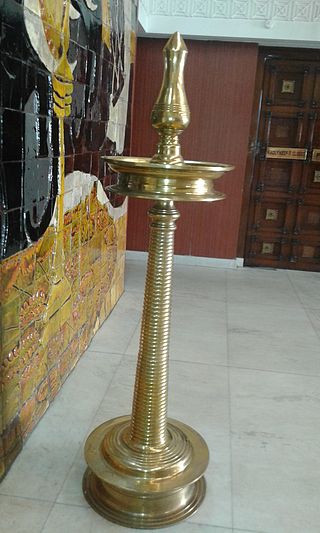Top Qs
Timeline
Chat
Perspective
Nilavilakku
Traditional lamp used in South India From Wikipedia, the free encyclopedia
Remove ads
Nilaviḷakku ⓘ is a traditional floor lamp used commonly in Kerala. Similar regional variations in India include Kuthuviḷakku (Tamil: குத்துவிளக்கு) in Tamil Nadu. It is called Kundulu in Andhra Pradesh and Telangana. It is called Deepada Kamba (ದೀಪದ ಕಂಬ) in Karnataka[1] It is known as and Samai (समई) in Maharashtra. In Odisha, its called Pilisajā/Pilibeṛhi (ପିଲିସଜା /ପିଲିବେଢ଼ି) in Odia. The traditional lamps, which are lit during every auspicious occasion, at homes and temples during prayer rituals, and on festive occasions.




Remove ads
Etymology
Nilam in the Malayalam/Tamil[1] language means floor or the ground and vilakku means lamp.
Usage
Summarize
Perspective
History
Vilakku/dīpam (lamp) is one of five accessories of religious worship in Hinduism, Jainism and Buddhism; others being puṣpa (flowers), dhūpa (incense), gandhā (sandalwood paste) and nivedya (food). Worshipping deities with these five accessories is generally considered as a way for achieving the four ends of human life; dharma, artha, kama and moksha.[2]
Vilakku lamps are used for various ceremonies, at home shrines, temples, weddings, and other festive occasions. A pair of lamps are typically placed at home shrines next to the deity for daily rituals. In Kerala, nilavilakku is integral to several rituals and ceremonies in Hindu families. As the sun sets, young girls of the family bring the lighted lamps to the verandah of the house, continue with evening prayers. In the evening, the ritual is repeated alongside evening prayers. In Hindu temples, various types of Nilavilakku like 'Kutthuvilakku', 'Thookkuvilakku' etc. are used and are very much related to the traditional beliefs and activities in Kerala.
Lighting the Nilavilakku on any occasion is believed to be auspicious. Nilavilakku plays an important role in the presentation of various art forms. The art forms are performed after lighting the lamp. In Kerala, many functions are inaugurated by lighting Nilavilakku.[3] A special type of Nilavilakku, called Aal Vilakku is used in Temples of South India, especially in Kerala.[4]
Nilavilakku is usually made of bronze or brass. Usually cotton wicks doused in oil or ghee are used for lighting the lamp. There are three ways of lighting the lamp. In one, only one wick is lit and is directed towards the deity or sacred space and in another, there are two lit wicks in two directions. The third alternative is with five wicks in five directions.
In Kerala, Saint Thomas Christians also started keeping Nilavilakku in their churches and homes. Traditionally, the nilavilakku is lighted and kept at the main front entrance of a home. Syrian Christian art forms like Margamkali and Parichamuttukali are performed around nilavilakku.
Remove ads
Gallery
- 13th century lamp, Kerala
- a lighted up nilavilakku
- Kuthuvillaku, Tamil Nadu
- Kuthuvillaku, Tamil Nadu
- Bronze lamp in 13th century, Kerala
- Nilavilakku lamps in typical Kerala style
- Nilavilakku lamps, Kerala
- Nirapara and Nilavilakku
- Bronze lamp used in Temples.
- Thookkuvilakku hanging lamp
- Thookkuvilakku hanging lamps
- Nilavilakku in Church with Christian cross
See also
- Other lamps
- Related topics
References
Wikiwand - on
Seamless Wikipedia browsing. On steroids.
Remove ads












